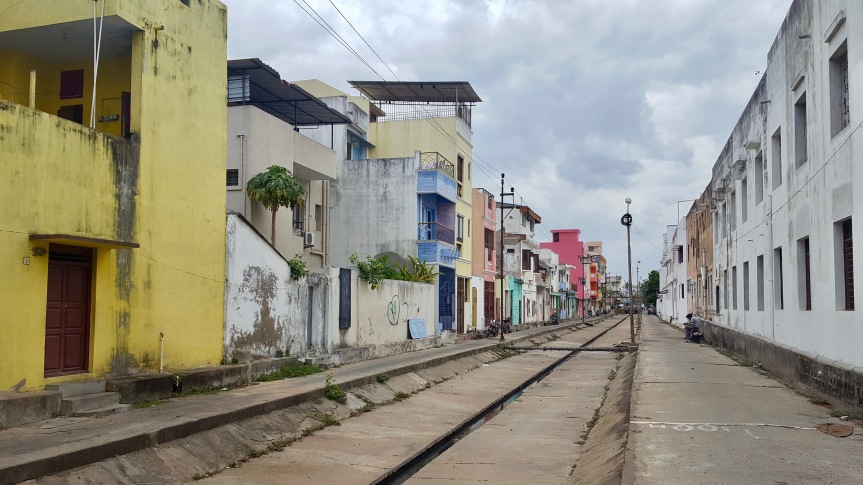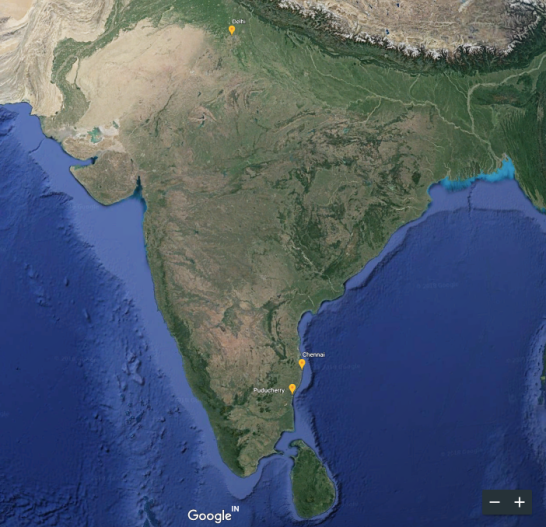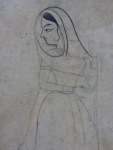
Arikamedu lies due south of White Town, on the southern bank of the Ariyankuppam River just as it meets the sea. It is not a particularly good place for a deepwater port, but no spot along the Coromandel Coast really is. The great rivers of the Tamil heartland, engorged by monsoon rains in the west, flood the coastal plains, meeting with the Bay of Bengal to form backwaters. It is here that a dynamic form of exchange occurred between coastal hamlets and ocean-going vessels, one mediated by smaller crafts that could navigate both the shallow marshes and the open sea.
Eighteenth-century Jesuits, who built a seminary here, first noticed the presence of western finds in their backyard. As rumors of cameos and pottery spread north, French scholars (including those at the EFEO) conducted cursory explorations in the 1930s and 40s. Many began to make the link between the area and the Podouke Emporion of Greco-Roman itineraries, which may or may not have some relation to the Tamil Puduchcheri (or “New Town”). Formal excavations began in 1945 under the auspices of the Archaeological Survey of India (ASI), directed by Sir Mortimer Wheeler.
From left: Ariyankuppam River, Arikamedu; Jesuit seminary, seventeenth century, Arikamedu; a refresher course on site reports, EFEO, Pondicherry.
With each excavation, the site assumed a new character. For Wheeler, the last colonial director of the ASI, Arikamedu represented Rome beyond its frontiers—an empire without end just as Britain’s was ending. The French excavations under Casal (1947–50) placed the port in a regional context of Megalithic sites, but maintained parts of this Romanocentric narrative. The site lay fallow for decades, until renewed interest sparked excavations by an international team under Begley (1989–92). Their findings not only clarified the earlier excavations, but extended the chronology of the site and reclaimed supposed imports as products of Indian ingenuity.
From these missions, we get a sense of a particular moment at Arikamedu—a Tamil port with a long history of trade on the backwaters, but one that participated in wider Indian Ocean networks for roughly two centuries, from the late first century BCE to the end of the second century CE. The sheer importance of this site for understanding the mechanics of ancient commerce has always excited me as a scholar. The tensions beneath the sand do much to challenge my preconceptions.
* * *
After hopping the fence to enter the archaeological site, you might initially think you have been duped by your rickshaw driver. Mango and coconut trees line sandy paths to a sheer drop-off above the river; low-lying vegetation and strategic backfills conceal the ancient remains. The only superstructure is the old seminary, whose arches of pilfered brick are often mistaken as Roman architecture. If you know where to look, you can find the devil in the details. Roman-era buildings peek out from the crumbling embankment. Ring wells, which once nourished the coastal settlement, can be seen in split profile, their shattered ribs exposed to the elements. Pottery of all periods litters the ground, mingling with the trash of less considerate visitors.
I am so glad to have met a local enthusiast, Ramesh, who alternates his time between reading in the EFEO library, exploring the site he loves, and publishing his discoveries. We toured Arikamedu together, musing in broken English over what we could find; he then graciously welcomed me into his family home to view his findings over coffee. I truly appreciated his knowledge and patience; without his help, I would have spent far more time scrapping my way through the brush.
From top-left: Reconstructed jewelry from bead finds in the area; traces of a ring well on the surface, Arikamedu; following Ramesh down the embankment, Arikamedu; traces of Roman period brick, Arikamedu; ring well, Arikamedu.
To bring life to the site, you must add a catalogue of excavated and chance finds from over the past 80 years. Arretine Ware, pottery linked to workshops in France, has a brief heyday in the early first century CE. Roman amphorae at Arikamedu span much longer, following the changes of production centers throughout the Roman Mediterranean, from Italian wine in the first century to Spanish products in the second. Indian Rouletted Ware adapts in this moment with foreign designs. Unworked gems from the interior arrive to the coast, waiting to be carved into the cameos of international taste. Local glass and stone beads produced here participate in a pan-Indian Ocean market. Terracotta figurines adopt Indian dress and posture, but also draw inspiration from the prodigious outputs at Alexandria.
Traces of foreigners in the city pool in the northern portion of the excavated area. Spanish fish sauce and Adriatic olive oil, products with no real market in India, perhaps sustained seasonal trading communities or even resident aliens. Pozzolana-like cement found on broken potsherds suggests the recycling of amphorae for underwater construction, a possible contribution of Mediterranean masonry for quays at the river mouth. Limited epigraphy reveals languages and scripts of merchants from throughout the subcontinent. Beyond the activities of foreigners, the port continued as it always had, watered by its ring wells, but with a view to the larger world.
* * *
The future of Arikamedu remains in doubt. For one thing, the site’s archaeological finds are not easily accessible. Many reside nearby in Pondicherry or Chennai; others have vanished, last seen in Hanoi or Paris over 50 years ago. The Pondicherry Museum, like many regional museums in India, is a trial of academic patience. Finds are jumbled in unlabeled glass cabinets, which stand alongside tattered furniture from old colonial mansions. Bricks from Arikamedu sit unprotected on a plastic side table lined with newsprint. The collection begs for some semblance of organization and pizzazz to captivate visitors. The strict anti-photography policy, even for researchers, obfuscates rather than protects; it effectively hides the disarray for the next victim.
Arikamedu faces many of the same pressures that affect archaeological sites around the globe. Talks of renewing excavations here or constructing an interactive visitor center sprout up sporadically, like the weeds that you find along the banks of the Ariyankuppam. Each time, the prospect has been starved by bureaucratic infighting, lack of funds, or public apathy. The current nationalist government tends to suppress projects that do not corroborate a narrative of Hindu supremacy in the subcontinent. Looting is a forgone conclusion, given that finds pop out of the sand at the slightest provocation. All the while, the river erodes the structures below; what pottery and brick the mangroves do not ensnare in their roots move slowly out to sea.
From top-left: Gemstones and beads, including carnelian cameo blank; Roman amphora fragment; Type 110 pottery; onyx fragments; pottery of all ages (from ancient period through 15th century).
The site lives up to one colleague’s description of a “festering sore,” constantly reopened by the tug-of-war between scholars of east and west, between rewriting the past and forgetting it, between man and nature. It can continue to change the landscape of ancient history, and yet, the prospect of an interconnected world cannot help but aggravate the scars of the colonial past. Doom and gloom aside, the efforts of people like Ramesh give me hope. He satisfies his own curiosities with research, but also eagerly shares his knowledge with others. He walks the grounds almost every day, noting advanced stages of erosion. He repeatedly petitions the government to invest more in site preservation for future generations. His heroic dedication reminds me that to study a site without understanding the stakes of its survival is an empty affair.
* * *
Visits to the Pondicherry Museum and Arikamedu straddled a week full of lectures on Indology at the Institut Français de Pondichéry (IFP), a fellow academic center that works closely with the EFEO. Otherwise, things in Pondy remain much the same. Last weekend, the gang made a trip to the temples of Kumbakonam; tomorrow, we may travel to Thanjavur, one of the capitals of the imperial Cholas. In the next week or so, I plan to study some of the other local sites related to ancient trade (many of which have not received extensive scholarly treatment). Stay tuned!
Written from White Town, Pondicherry
N.B. All photos are by the author unless otherwise noted. For those interested, I have whipped up a brief bibliography of the relevant site reports for Arikamedu (along with a few extra scholarly treatments).





































































